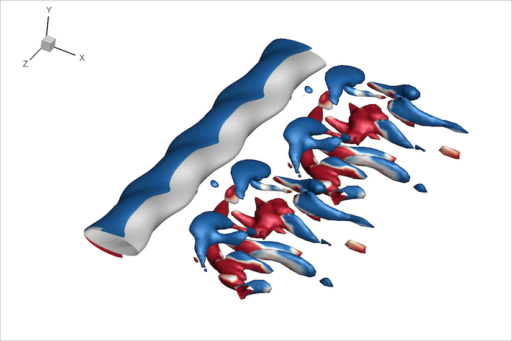Seals have an incredible ability to track their prey underwater thanks to the unique geometry of their whiskers.
Unlike the smooth whiskers of cats and dogs, seal whiskers have wavy surfaces that help them detect disturbances in the water caused by their prey.
 Jennifer Franck
Jennifer Franck
“Seal whiskers have what we call an undulated cylinder geometry, and research has shown that this geometry significantly reduces forces and vibrations that result from interactions with fluids, making it attractive for many potential engineering applications,” says Jennifer Franck, an assistant professor of nuclear engineering and engineering physics at the University of Wisconsin-Madison.
Franck is leading a National Science Foundation-funded research project to study the interactions between fluid flow and undulated cylindrical structures.
“Ultimately, we want to understand how the fluid moves across these complex surfaces, and how changes in the surface’s geometry will affect the flow response around it,” Franck says.
The research has applications in a variety of areas. For example, it could aid in building cheaper flow sensors for unmanned underwater vehicles that could monitor currents and detect disturbances in the water.
Findings from the research could also help reduce the cost of building wind turbine towers. With tall wind turbines, the towers themselves produce a significant amount of drag. And a strong flow of wind around a tower can cause it to vibrate.
 An image from one of Jennifer Franck’s simulations of fluid flow around an undulated cylindrical structure.
An image from one of Jennifer Franck’s simulations of fluid flow around an undulated cylindrical structure.
“The idea is that having some undulations and carefully designed shapes on these tall towers could reduce the drag and vibrations and make them less expensive to build,” Franck says.
In this interdisciplinary project, Franck is leveraging her expertise using computational simulations to investigate fluid mechanics. She is collaborating with Raúl Bayoán Cal, a Portland State University mechanical and materials engineering professor who is conducting wind tunnel experiments, and Christin Murphy, who runs the Bio-Inspired Research and Development Laboratory at the Naval Undersea Warfare Center in Newport, Rhode Island.
Franck and her collaborators are also conducting simulations and experiments to investigate how an array of seal whiskers, which are packed close to one another, functions as a system.
For example, Franck says the flow that happens in the wake of the first whisker will influence the flow interaction with the second whisker, which will then influence the next whisker in the group and so on.
This research could also improve understanding of ecological systems, such as how weather systems interact with forests.
“In forests, trees—which are kind of shaped like undulated cylinders—are packed close together in arrays. When a strange weather pattern comes through, how will it affect the flora and fauna that live in this ecosystem? We could develop models to look at how the wind patterns will affect the trees at the beginning of the field compared to trees in the middle and trees at the edge,” Franck says.